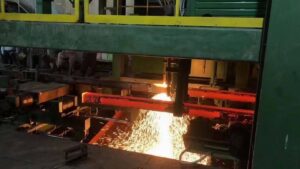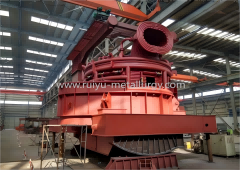Continuous casting machine through the liquid steel poured into the water-cooled copper crystallizer, so that the steel along the crystallizer periphery gradually solidified into a billet shell, to be the liquid steel level rises to a certain height, the billet shell solidified to a certain thickness, by the straightening machine will be pulled out of the billet, and by the secondary cooling zone water cooling to make the casting billet completely solidified, and finally by the cutting device according to the requirements of the rolled steel cut to fixed size.
In the iron and steel industry, continuous casting machine has become one of the key equipments for producing pig iron, refined steel and cast iron. It not only improves production efficiency, reduces energy consumption and costs, but also produces high quality products to meet the market demand for high quality steel. Continuous casting machine market demand continues to grow, mainly due to the global economic growth and industrialization process. With the expansion of infrastructure development and manufacturing industries, the demand for steel and other metals is increasing, which directly contributes to the demand for continuous casting machines market. Especially in some developing countries, such as China and India, with the acceleration of infrastructure construction and urbanization, the demand for continuous casting machines is even stronger.
Status.
With the rapid development of automobile, construction and other industries, the demand for high-quality steel will also continue to increase, which in turn will promote the expansion of continuous casting machine market. At present, the continuous casting machine industry has achieved remarkable development results.
Technology: Continuous casting technology has received significant technological innovations and improvements over the past few decades, including automated control, improved accuracy, and increased energy efficiency. These technological advances have enabled continuous casting machines to produce high-quality metal products more efficiently, enhancing their competitiveness in the market.
Market Side: The major markets for the continuous casting machine industry are centered in the world’s major steel-producing countries and regions, such as China, India, Japan, Europe and North America. The market demand and technology level of these regions have an important impact on the development of continuous casting machine. At the same time, with the deep development of globalization, the role of international cooperation in the continuous casting machine market is more and more important. Through international cooperation, enterprises can introduce advanced technology and management experience to enhance their competitiveness.
Future Development.
With the continuous progress of science and technology, continuous casting machine market will usher in a new stage of technological innovation and intelligent development. The application of intelligent technology will make continuous casting machine can realize more accurate monitoring and control, so as to improve production efficiency and product quality. In addition, the research and development and application of new materials will also promote the innovation and development of continuous casting machine technology. In addition, with the global environmental awareness and energy consumption limitations, continuous casting machine industry will pay more attention to environmental protection and energy saving. In the future, environmentally friendly continuous casting machine will become the mainstream products in the market, to meet the market requirements for green manufacturing and energy saving and emission reduction.In some emerging markets and developing countries, with the acceleration of industrialization and urbanization, the demand for continuous casting machine will be more vigorous. With the deep development of globalization, the role of international cooperation in the continuous casting machine market will be more important. Through international cooperation, enterprises can expand overseas markets and increase the diversity and stability of business. At the same time, enterprises can also introduce advanced technology and management experience to enhance their competitiveness.





